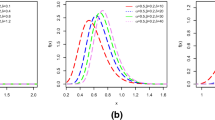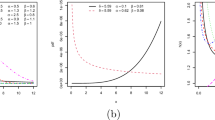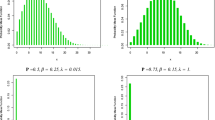Abstract
The Bayesian approach is applied to estimation of the Weibull-power law process (WPLP) parameters as an alternative to the maximum likelihood (ML) method in the case when the number of events is small. For the process model considered we propose to apply the independent Jeffreys prior distribution and we argue that this is a useful choice. Comparisons were also made between the accuracy of the estimators obtained and those obtained by using other priors—informative and weakly informative. The investigations show that the Bayesian approach in many cases of a fairly broad collection of WPLP models can lead to the Bayes estimators that are more accurate than the corresponding ML ones, when the number of events is small. The problem of fitting the WPLP models, based on ML and Bayes estimators, to some real data is also considered. It is shown that the TTT-concept, used in the reliability theory, is not fully useful for the WPLP models, and it may be so for some other trend-renewal processes. In order to assess the accuracy of the fitting to the real data considered, two other graphical methods are introduced.




























Similar content being viewed by others
References
Aminzadeh MS (2013) Bayesian estimation of the expected time of first arrival past a truncated time T: the case of NHPP with power law intensity. Comput Stat 28:2465–2477
Andersen PK, Borgan Ø, Gill RD, Keiding N (1993) Statistical models based on counting processes. Springer series in statistics. Springer, New York
Bandyopadhyay N, Sen S (2005) Non-standard asymptotics in an inhomogeneous gamma process. Ann Inst Stat Math 57(4):703–732
Bar-Lev SK, Lavi I, Reiser B (1992) Bayesian inference for the power law process. Ann Inst Stat Math 44(4):623–639
Barlow RE, Campo R (1975) Total time on test processes and applications to failure data analysis. In: Reliability and fault tree analysis (Conf., Univ. California, Berkeley, Calif.), pp 451–481 (1974)
Bebbington MS (2013) Assessing probabilistic forecasts of volcanic eruption onsets. Bull Volcanol 75:783
Bergman B, Klefsjö B (1984) The total time on test concept and its use in reliability theory. Oper Res 32(3):596–606
Brémaud P (1981) Point processes and queues. Springer, New York. Martingale Dynamics, Springer series in statistics
Calabria R, Pulcini G (1997) Bayes inference for modulated power law process. Commun Stat Theory Methods 26(10):2421–2438
Canavos GC, Tsokos CP (1973) Bayesian estimation of life parameters in the Weibull distribution. Oper Res 21(3):755–763
Chen Z (2010) Empirical Bayes analysis on the power law process with natural conjugate priors. J Data Sci 8(1):139–149
Dawid AP, Stone M, Zidek JV (1973) Marginalization paradoxes in Bayesian and structural inference. J R Stat Soc Ser B 35:189–233. With discussion by D. J. Bartholomew, A. D. McLaren, D. V. Lindley, Bradley Efron, J. Dickey, G. N. Wilkinson, A. P.Dempster, D. V. Hinkley, M. R. Novick, Seymour Geisser, D. A. S. Fraser and A. Zellner, and a reply by A. P. Dawid, M. Stone, and J. V. Zidek
Duane JT (1964) Learning curve approach to reliability monitoring. IEEE Trans Aerosp 2:563–566
Eaton ML, Sudderth WD (1998) A new predictive distribution for normal multivariate linear models. Sankhyā Ser A 60(3):363–382 (Bayesian analysis)
Eaton ML, Sudderth WD (2004) Properties of right Haar predictive inference. Sankhyā 66(3):487–512
Engelhardt M, Bain L (1978) Prediction intervals for the Weibull process. Technometrics 20(2):167–169
Franz J (2006) Posterior distribution and loss functions for parameter estimation in Weibull processes. Econ Qual Control 21(1):31–42
Franz J, Pietzner D (2012) Trend-incomplete-renewal process models for repairable systems. Econ Qual Control 27(1):65–83
Franz J, Jokiel-Rokita A, Magiera R (2014) Prediction in trend-renewal processes for repairable systems. Stat Comput 24(4):633–649
Guida M, Calabria R, Pulcini G (1989) Bayes inference for a non-homogeneous Poisson process with power intensity law reliability. IEEE Trans Reliab 38(5):603–609
Gupta PK, Singh AK (2017) Classical and Bayesian estimation of Weibull distribution in presence of outliers. Cogent Math 4:1300975
Guure CB, Ibrahim NA, Ahmed AM (2012) Bayesian estimation of two-parameter Weibull distribution using extension of Jeffreys’ prior information with three loss functions. Math Probl Eng 2012:589640
Heath D, Sudderth W (1978) On finitely additive priors, coherence, and extended admissibility. Ann Stat 6(2):333–345
Heath D, Sudderth W (1989) Coherent inference from improper priors and from finitely additive priors. Ann Stat 17(2):907–919
Hu J-M, Huang H-Z, Li Y-F, Gao H-Y (2020) Bayesian prior information fusion for power law process via evidence theory. Commun Stat Theory Methods 1–19
Huang Y-S, Bier VM (1998) A natural conjugate prior for the non-homogeneous Poisson process with a power law intensity function. Commun Stat Simul Comput 27(2):525–551
Hurtado JL, Joglar F, Mohammad M (2005) Generalized renewal process models, parameter estimation and applications to maintenance problems. Int J Perform Eng 1(1):37–50
Jeffreys H (1946) An invariant form for the prior probability in estimation problems. Proc R Soc Lond Ser A 186:453–461
Jeffreys H (1961) Theory of probability, 3rd edn. Clarendon Press, Oxford
Jokiel-Rokita A, Magiera R (2012) Estimation of parameters for trend-renewal processes. Stat Comput 22:625–637
Jokiel-Rokita A, Magiera R (2016) On the existence of maximum likelihood estimates in modulated gamma process. Int J Econ Stat 4:203–209
Jokiel-Rokita A, Magiera R (2018) Estimation and prediction for the modulated power law process. Springer, Cham, pp 443–447
Klefsö B, Kumar U (1993) Goodness-of-fit tests for the power-law process based on the ttt-plot. IEEE Trans Reliab 41(4):593–598
Langberg NA, León RV, Proschan F (1980) Characterization of nonparametric classes of life distributions. Ann Probab 8(6):1163–1170
Lindqvist BH (1993) The trend-renewal process, a useful model for repairable systems. In: Society of reliability engineers, Scandinavian chapter, annual conference, Malmö, Sweden
Lindqvist BH (2006) On the statistical modeling and analysis of repairable systems. Stat Sci 21(4):532–551
Lindqvist BH, Doksum KA (eds) (2003) Mathematical and statistical methods in reliability, volume 7 of Series on quality, reliability and engineering statistics. World Scientific Publishing Co. Inc., River Edge. Papers from the 3rd International Conference in Mathematical Methods in Reliability held in Trondheim, June 17–20, 2002
Lindqvist BH, Elvebakk G, Heggland K (2003) The trend-renewal process for statistical analysis of repairable systems. Technometrics 45(1):31–44
Lindqvist BH, Kjønstad GA, Meland N (1994) Testing for trend in repairable system data. In: Proceedings of ESREL’94, La Boule, France
Pietzner D, Wienke A (2013) The trend-renewal process: a useful model for medical recurrence data. Stat Med 32(1):141–152
Rigdon SE, Basu AP (2000) Statistical methods for the reliability of repairable systems. Wiley, New York
Ross SM (2013) Simulation, 5th edn. Elsevier/Academic Press, Amsterdam
Saito Y, Dohi T (2015) Robustness of non-homogeneous gamma process-based software reliability models. In: 2015 IEEE international conference on software quality, reliability and security, pp 75–84
Sen A (2002) Bayesian estimation and prediction of the intensity of the power law process. J Stat Comput Simul 72(8):613–631
Sinha SK, Zellner A (1990) A note on the prior distributions of Weibull parameters. SCIMA 19:1–2
Tang Y, Fu J, Liu W, Xu A (2017) Bayesian analysis of repairable systems with modulated power law process. Appl Math Model 44:357–373
Wang Y-P, Lu Z-Z (2011) Bayesian inference and prediction analysis of the power law process based on a gamma prior distribution. Commun Stat Simul Comput 40(9):1383–1401
Wang Y-P, Lu Z-Z (2015) Bayesian inference and prediction analysis of the power law process based on a natural conjugate prior. J Stat Comput Simul 85(5):881–898
Zhou H, Rigdon SE (2008) Duration dependence in US business cycles: an analysis using the modulated power law process. J Econ Finance 32:25–34
Zhou H, Rigdon SE (2011) Duration dependence in bull and bear stock markets. Mod Econ 2:279–286
Acknowledgements
We would like to thank the Referees very much for their valuable comments and suggestions.
Author information
Authors and Affiliations
Corresponding author
Additional information
Publisher's Note
Springer Nature remains neutral with regard to jurisdictional claims in published maps and institutional affiliations.
Rights and permissions
About this article
Cite this article
Jokiel-Rokita, A., Magiera, R. Bayesian estimation versus maximum likelihood estimation in the Weibull-power law process. Comput Stat 38, 675–710 (2023). https://doi.org/10.1007/s00180-022-01241-4
Received:
Accepted:
Published:
Issue Date:
DOI: https://doi.org/10.1007/s00180-022-01241-4




